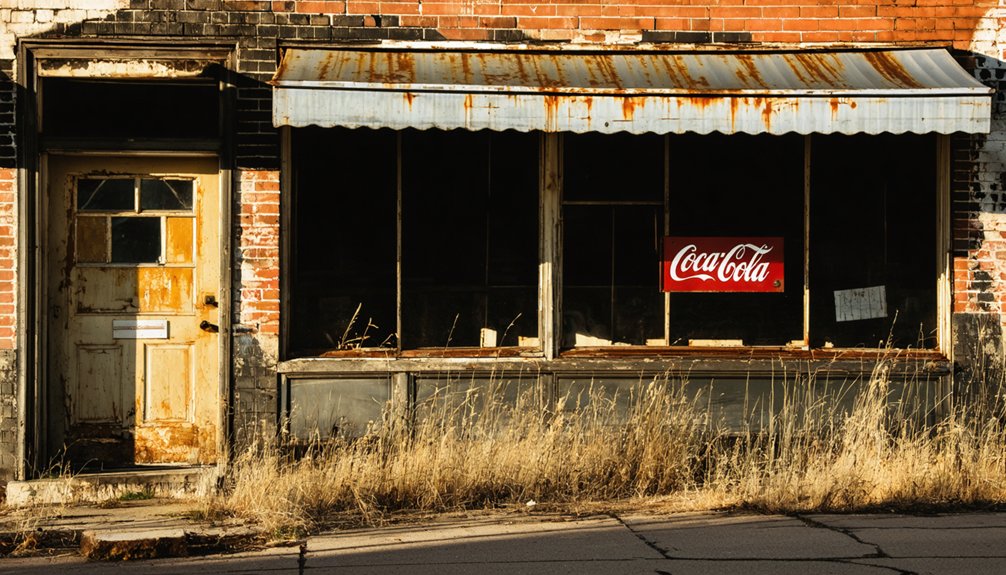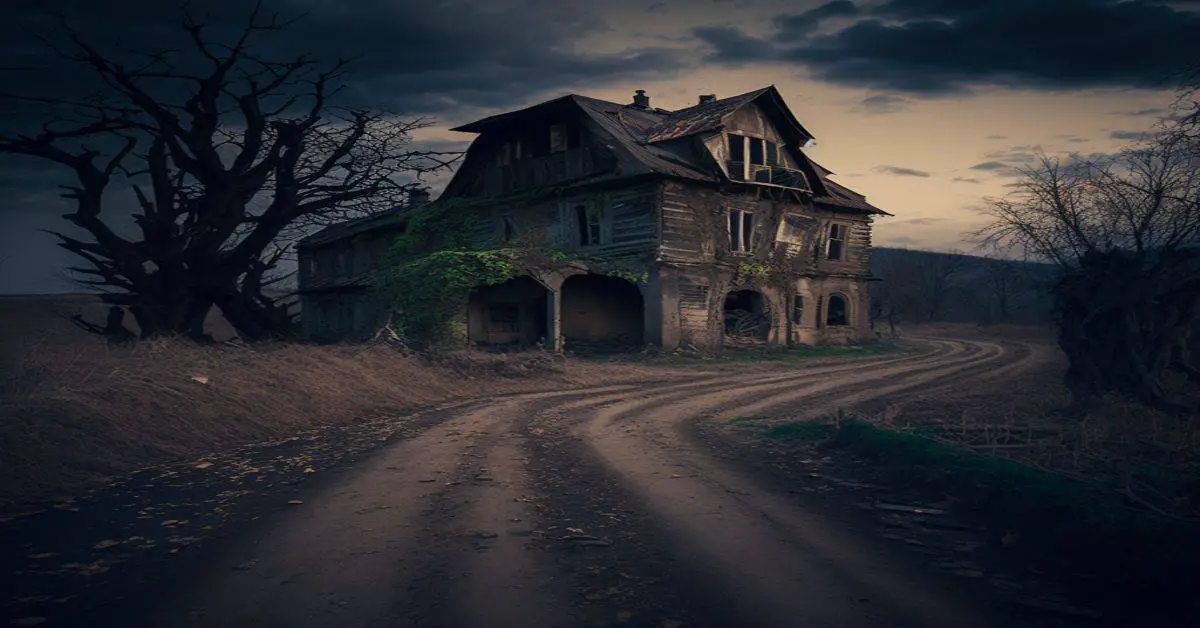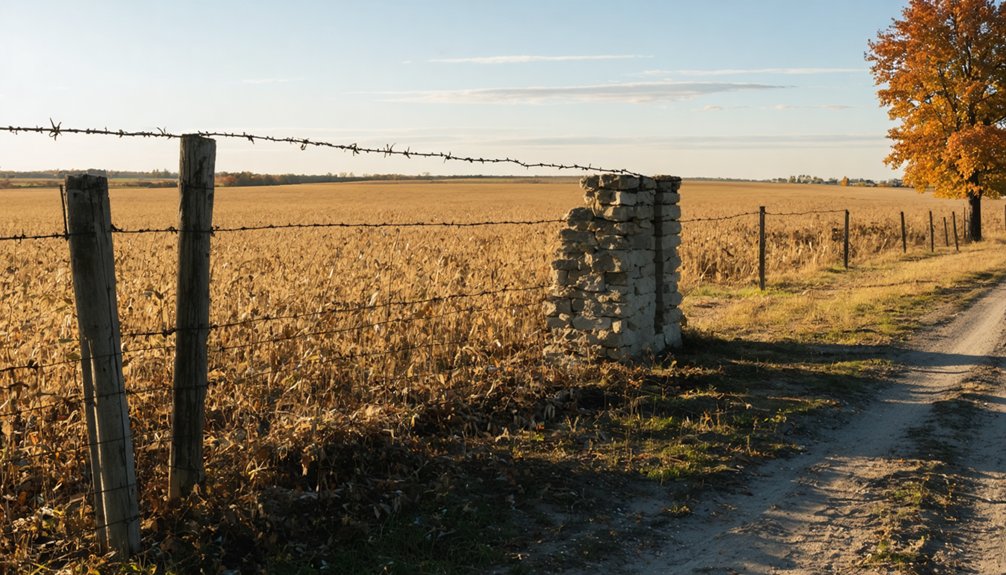You’ll find the ghost town of Barr in Macoupin County, Illinois, where Joseph Elliott first settled as a squatter in 1828. The community grew around Barr’s Store, established by James B. Steidley in 1865, becoming a vibrant hub with general stores, physicians’ offices, and a post office. By the early 1900s, railroads and improved roads drew commerce away, leading to its abandonment. Today, deteriorating structures and overgrown pathways reveal traces of this once-bustling 19th-century trading post.
Key Takeaways
- Barr began as Barr’s Store in 1865, founded by James B. Steidley and named after Benjamin R. Barr in Macoupin County, Illinois.
- The town flourished as a commercial center with general stores, physicians’ offices, blacksmith shops, and a post office during the late 1800s.
- The community’s second-floor meeting hall hosted local elections and social gatherings of the Modern Woodmen of America Camp.
- Barr declined in the early 1900s due to railroad development and improved roads drawing commerce to larger towns.
- Today, the ghost town features deteriorating structures, visible street patterns, and foundation ruins that showcase its 19th-century heritage.
Early Days: Pioneer Settlement and Founding
When Joseph Elliott first settled as a squatter in section 21 of Barr Township around 1828-1829, he pioneered what would become a steady stream of settlers from Kentucky and neighboring states.
You’ll find that other early settler experiences included John Markham in 1830, followed by J.W. Henderson, George O. Solomon, and the Metcalf brothers throughout the early 1830s.
The area’s early challenges were significant – dense woodlands filled with bears near Bear Creek and Bear-Rough Point marked the rugged frontier environment. These pioneers used plows and hoes to transform the wilderness into productive farmland.
By 1865, James B. Steidley laid out Barr’s Store, named after Benjamin R. Barr, who established the community’s first store and post office.
This two-story frame building became the heart of the settlement, with its upper floor serving as a community gathering space and polling place.
The town eventually grew to include a bustling general store and hotel that served the local community until economic struggles led to its decline.
The Rise of Barr’s Store and Community Life
The establishment of Barr’s Store in 1865 transformed a scattered rural settlement into a vibrant community hub. Benjamin R. Barr’s two-story frame building served multiple purposes beyond mere commerce, housing a marketplace below and a community hall above where you’d find locals gathering for lodge meetings and casting their votes on election day.
The store’s significance extended through its role as a center for community exchange. You’d see women trading their farm-fresh eggs, butter, and chickens for household essentials like calico fabric, coal oil, and spices. The store register records from 1849-1850 documented these daily transactions in detail.
While men socialized outside, the store buzzed with activity inside, from mail distribution to candy purchases by children with spare pennies.
Additional businesses soon followed, including two physicians’ offices, a blacksmith shop, and a shoe shop, creating a self-sustaining local economy. By 1879, the commercial district had grown to include two general stores operated by J. G. Young and J. H. Hinkle.
Economic Activities and Social Gatherings
Inside Barr’s Store, a diverse economic ecosystem flourished through the exchange of farm products and manufactured goods. You’d find local women trading their butter, eggs, and chickens for necessities like sugar, calico, thread, and coal oil – a reflection of the area’s active barter economy.
The store’s second floor served multiple functions, hosting election polling and Modern Woodmen of America Camp meetings that strengthened social cohesion among residents. Men gathered on benches outside, sharing news and stories while waiting for the bi-weekly mail delivery from the store’s partitioned office. Much like today’s struggling rural communities, the store served as both an economic and social hub for local residents.
Children spent odd pennies on peppermint candy, while farmers traded their seasonal produce for salt and spices, creating an interconnected web of commerce that kept this rural community thriving.
The Path to Abandonment
Despite its vibrant commercial peak in the late 1800s, Barr’s steady decline began in the early 1900s as economic forces reshaped rural America.
You’d have witnessed the gradual population decline as local businesses couldn’t compete with larger towns, and families sought opportunities elsewhere. The advent of railroads and improved roads drew commerce away from Barr’s once-bustling streets toward bigger economic hubs.
Like countless small towns, Barr slowly faded as railways and better roads led people and business toward larger communities.
Transportation changes meant you could easily reach larger markets, making Barr’s local services less crucial. Like the nearby town of Benld in Macoupin, Barr’s economy had heavily depended on coal mining operations. After serving the community since 1895, the post office closed in 1905, marking a significant milestone in the town’s decline.
As residents left, the town’s crucial institutions began to fade. The post office closed, the Methodist Church emptied, and the IOOF Hall fell silent.
Barr’s transformation from a thriving community to abandonment wasn’t caused by any natural disaster – it simply couldn’t adapt to the changing economic landscape of the twentieth century.
Exploring the Ghost Town Today
Today’s visitors to Barr encounter a haunting tableau of deteriorating structures and overgrown pathways where a bustling community once stood.
You’ll find yourself exploring ruins of the general store, post office, and hotel scattered across the central Illinois landscape. The original street patterns remain visible, guiding your journey through this abandoned slice of Macoupin County history.
While exploring ruins, you’ll need to navigate carefully through uneven terrain and seasonal vegetation. The site’s accessibility depends on weather conditions and proper permissions, as it’s surrounded by private farmland.
Keep an eye out for historical artifacts and building foundations that offer glimpses into 19th-century life. The quiet atmosphere and rural setting create an immersive experience, though you won’t find modern amenities or interpretive signage here.
Frequently Asked Questions
Are There Any Documented Paranormal Activities or Ghost Sightings in Barr?
You’ll find no documented ghost encounters or haunted locations here – despite what your imagination might conjure in this abandoned prairie town, historical records show zero supernatural activity in Barr.
What Happened to the Original Barr Family After the Town’s Decline?
You won’t find clear records of the Barr family’s fate after the town’s decline. Their descendants’ whereabouts and legacy remain unclear, as historical documentation stops tracking them in the early 1900s.
Did Any Major Crimes or Notable Incidents Occur in Barr’s History?
You won’t find unsolved mysteries or historical crime records from Barr. The town’s activities centered peacefully around its general store and post office, with daily life focused on commerce and community gatherings.
Were There Any Native American Settlements in the Area Before Barr?
You’ll find Native tribes like the Peoria and Cahokia used the Macoupin Creek valley for hunting, but didn’t maintain permanent settlements. Earlier Woodland and Hopewell cultures left burial mounds in the area.
How Many People Were Living in Barr During Its Peak Population?
You won’t find exact records of Barr’s peak population, but given the township’s modest size – just 329 residents in 2010 before population decline – it’s estimated only 50-100 people lived there during peak years.
References
- https://illinoisstateonline.com/ghost-towns-in-illinois/
- http://genealogytrails.com/ill/macoupin/barr.html
- https://macoupin.illinoisgenweb.org/history/barrtownship.html
- https://macoupin.illinoisgenweb.org/places.html
- http://livinghistoryofillinois.com/pdf_files/History of Macoupin County
- https://collections.carli.illinois.edu/digital/api/collection/sie_brink/id/1644/download
- https://mchssociety.org/macoupin-county-history-families/
- https://www.ghosttowns.com/states/il/barr.html
- https://en.wikipedia.org/wiki/List_of_ghost_towns_in_Illinois
- https://mchssociety.org/barr-barrs-store/


